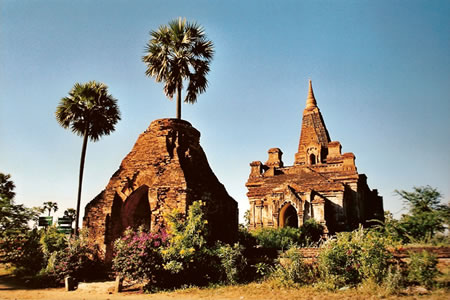English | Dutch |
|
| Bagan by bicycle | |
Mandalay (Myanmar), November 26th 2002 |
|
Without any doubt, Bagan is the most impressive destination in Myanmar (former Burma), and probably also in the whole of south East Asia. Bagan can compete easily with similar kind of destinations like the temples of Angkor in Cambodia or the Borbodur in Indonesia. However, Bagan is less known that its rivals in Cambodia and Indonesia, but does not make it less interesting. On the contrary, it makes it even more interesting.
Across an area of 40 square kilometers, the most impressive pathos (temples) and stupas (religious Buddhist monuments) are scattered. It doesn’t matter in what direction you look, everywhere and everywhere you will see stylish, glorious and beautiful buildings. It gives you the feeling to be in a fairytale world. Bagan is the biggest Buddhist archeological site in the world. And again, probably also the most impressive. |
|
 |
|
One of the many temples of Bagan |
|
| Although Bagan is much older, the golden age of Bagan started in the year 1057 after Christ. This is the year that king Anaw-rahta occupied the capital city of the Mon people, Thaton. The Mon people were the most powerful people in the present Myanmar area at that time. King Anaw-rahta decided to move the capital to Bagan and forced all Mon people to move with him to Bagan. From that moment on, Bagan grew to a metropolis city of more than 200.000 people. King Anaw-rahta is the initiator of the first Burmese empire and during the 240 years in where the empire was very powerful, the activity of building new temples and stupas never stopped. The result is that the Unesco recognized 2229 ruins as inheritance of mankind. However, many researchers state that the total number of buildings from that period exceeds the 120000.
Bagan is especially famous for its architecture of the buildings. In principle, the buildings of Bagan can be divided in two types of buildings: stupas (also called pagodas) and temples. A stupa is a building in where a relic is kept, like a tooth or hair of Buddha. On the other hand, a temple is a building in where Buddhist rites happen, the meditation and the devotion towards a Buddha statue. Bagan is a great destination for all types of travelers. If you have special interests in history or architecture, you will have a great time in Bagan. But also for the visitors without these special interests, Bagan will be a destination with magic. Especially when you decide to invest some time to see a sunset or sunrise from one of the temples, you will experience the fantastic beauty of this area. | |
 |
|
Beautiful sunrise at Bagan |
|
| Bagan is a perfect place to explore by bicycle. The area is flat and the bicycle gives you the possibility to see the area on your own pace. In the small villages of Bagan and Nyaung U you will find several places where you can hire bicycles. Be sure that you check the bicycles thoroughly, because the quality of the bicycles varies much. And because of the size of the area, a broken bicycle can lead to a long walk homewards. However, you always have the possibility to hire an ox cart.
The exploration of the area gets a special dimension through the small farming villages in this area. This gives you the possibility to stop once a while in the small villages and get in touch with the local people. The bicycle is the perfect means of transport for this. The fact that not many foreign people visit Bagan, gives another dimension to your visit. It gives you the possibility to explore the temples and stupas without the presence of any other visitors (only some local kids who are interested by your presence). Besides that, there is no extensive tourist industry, which means no persistent sales people try to sell local souvenirs. Bagan is a fabulous destination in South East Asia and should be on anyone’s list with plans to visit this country. On the other hand, it wouldn’t be that bad if travelers decide to stay away from this area the next couple of decades. Because like many other places, the magic partly disappears when it becomes a well-visited tourist destination. | |